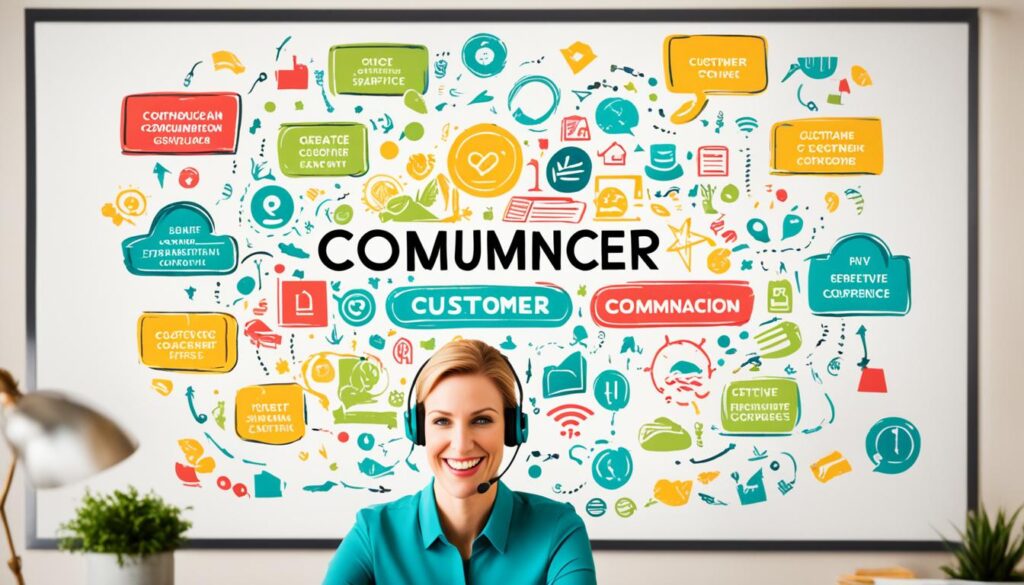Welcome to our comprehensive guide on mastering communication styles in customer service. Effective communication is the cornerstone of successful customer relationships and team dynamics. By understanding different communication styles, customer service teams can enhance their communication skills, improve customer satisfaction, and implement best practices that drive positive outcomes.
In this article, we will delve into the various communication styles that customer service teams should be aware of. We will explore the impact of a good customer communication strategy, discuss six rules to improve customer communication, and provide examples of companies that excel in customer communication best practices. Additionally, we will explore behavior styles in customer communication and the importance of adapting to different communication styles to build emotional bonds with customers.
By the end of this article, you will have a deep understanding of how to master communication styles in customer service and create meaningful connections with your customers. So let’s dive in and discover the secrets to effective customer communication!
What is Customer Service Communication?
Customer service communication is the act of actively listening to clients, deciphering their messages, and taking action to improve their experience with a product or service. It involves reading between the lines, understanding what is not being said, and finding new ways to help based on the information customers hold back.
Effective customer communication is the foundation of every profitable business relationship. By actively listening to customers, you can identify their needs, address their concerns, and provide personalized solutions. This level of communication not only improves their experience with your product or service but also demonstrates empathy and shows that you value their business.
Actively listening to customers is essential for understanding their perspectives and gaining insights into their expectations. It helps you uncover hidden pain points and provides valuable information for enhancing your product or service. By actively engaging in customer service communication, you can foster strong relationships, build trust, and establish a loyal customer base.
Customer service communication is a two-way street. As a customer service representative, it’s not only about providing information or assistance, but also about receiving feedback and actively responding to customer concerns. By actively listening and engaging in meaningful conversations, you create a dialogue that allows for continuous improvement and ensures that customers feel heard and understood.
The key to effective customer service communication lies in actively listening, understanding, and responding to your customers’ needs. By doing so, you can improve their experience with your product or service, foster long-term relationships, and consistently deliver exceptional customer service.

Customer service communication is not just about providing assistance; it’s about building connections and improving the overall customer experience. By actively listening, you can gather valuable insights, address customer concerns, and create personalized solutions. This level of communication fosters trust, reinforces the importance of customers, and sets the foundation for long-lasting relationships.
The Impact of a Good Customer Communication Strategy
A good customer communication strategy has a significant impact on the overall customer experience. It ensures that every touchpoint leaves clients with a positive feeling and a sense of value. Demonstrating empathy in customer communication builds trust in the brand. Providing a safety net for potential issues reassures clients of ongoing support, even in challenging situations. Acknowledging customers reinforces their importance and fosters a sense of belonging. A well-executed customer communication strategy enhances customer satisfaction and strengthens the relationship between customers and the brand.
Customer communication is not just about conveying information; it is about creating a positive emotional connection with your customers. When customers feel valued and understood, they are more likely to develop loyalty towards your brand. By implementing a customer communication strategy that prioritizes positive feelings, empathy, ongoing support, and the reinforcement of importance, you can foster strong and long-lasting relationships with your customers.
One of the key elements of a successful customer communication strategy is empathy. When customers feel that you understand their needs and concerns, they are more likely to trust your brand and remain loyal. Empathy allows you to anticipate their needs and provide personalized solutions. By empathizing with your customers, you can create a positive and supportive environment that promotes customer satisfaction and loyalty.
Ongoing support is another crucial component of a good customer communication strategy. Customers want to know that they can rely on your brand even after a transaction or interaction is complete. By offering ongoing support, you assure your customers that you are there for them, no matter what challenges they may face. This ongoing support reinforces their trust in your brand and builds a strong foundation for long-term relationships.
Reinforcing the importance of your customers is vital for creating a positive customer experience. When customers feel valued and appreciated, they are more likely to become advocates for your brand. By acknowledging their loyalty and thanking them for their support, you create a sense of belonging and reinforce their importance to your business.
A well-executed customer communication strategy, focused on positive feelings, empathy, ongoing support, and the reinforcement of importance, can differentiate your brand from competitors and create a memorable customer experience. It sets the stage for building strong customer relationships based on trust, loyalty, and mutual understanding.
Benefits of a Good Customer Communication Strategy:
- Enhanced customer satisfaction.
- Increased customer loyalty and advocacy.
- Improved brand reputation.
- Stronger customer relationships.
- Higher customer retention rates.
Investing in a customer communication strategy that prioritizes positive feelings, empathy, ongoing support, and the reinforcement of importance is crucial for modern businesses. By focusing on these elements, you can create a customer-centric approach that drives customer satisfaction and ultimately contributes to the success of your business.
| Key Components of a Good Customer Communication Strategy | Benefits |
|---|---|
| Demonstrating empathy | – Builds trust in the brand |
| Providing ongoing support | – Reassures clients of ongoing assistance |
| Reinforcing the importance of customers | – Fosters a sense of belonging |
| Promoting positive feelings | – Creates a memorable customer experience |
Six Rules to Improve Customer Communication
Improving customer communication is crucial for enhancing customer satisfaction and building strong relationships. By following these six essential rules, customer service teams can improve their communication strategies and ensure a positive experience for every customer.
Rule 1: Real Human Interaction
To improve customer communication, approach each customer as an individual and make them feel valued. Remind them of their investment in finding a solution and personalize every interaction. Reduce the number of touchpoints to streamline the communication process and improve clarity by repeating the customer’s issue to ensure understanding.
Rule 2: Positive Language
Use positive language in all customer interactions. Avoid negative words and phrases that can undermine the customer’s experience. Always end the communication on a positive note to leave a lasting impression.
Rule 3: Omnichannel Communication
Create an omnichannel communication experience by engaging customers across all digital channels. Ensure consistent messaging and provide seamless transitions as customers move between different communication channels. This approach allows customers to choose the most convenient method of communication while maintaining a unified experience.
Rule 4: Hybrid Support
Offer hybrid support that combines traditional support methods with self-support and automation. Provide customers with options to access assistance through various channels, including live chat, self-service knowledge bases, and automated solutions. This approach maximizes efficiency and empowers customers to find solutions independently.
Rule 5: Flawless First-Time Experience
Deliver a flawless first-time customer experience by focusing on speed, ease of use, and accessibility. Minimize wait times and ensure that customers can quickly access the information or assistance they need. Simplify processes and eliminate barriers to provide a smooth and effortless experience.
Rule 6: Perfecting Communication Style
Master the art of assertive communication to ensure clear and effective communication. Assertiveness involves expressing thoughts, needs, and concerns confidently while respecting the customer. By practicing assertive communication, customer service teams can address customer issues promptly and professionally.

Implementing these six rules will help customer service teams improve their communication strategies and provide an exceptional customer experience. By focusing on real human interaction, positive language, omnichannel communication, hybrid support, delivering a flawless first-time experience, and perfecting communication style, customer service teams can enhance customer satisfaction and build lasting relationships.
The Different Communication Styles Customers Service Reps Should Know
Effective customer service relies on understanding and adapting to different communication styles. As a customer service representative, it’s crucial to be familiar with various communication styles to effectively interact with clients. By recognizing and appropriately responding to these styles, you can build stronger connections and provide exceptional service. The main communication styles to be aware of are:
- Assertive Communication: This style involves expressing thoughts, feelings, and needs openly while maintaining professionalism. Assertive communicators are confident, honest, and actively listen to clients.
- Passive Communication: In contrast, passive communicators avoid expressing their thoughts or needs, potentially making clients feel unheard or unattended. This style often lacks assertiveness and may hinder effective communication.
- Aggressive Communication: Aggressive communicators express their thoughts and needs forcefully, often disregarding the feelings of others. This style can escalate conflicts and lead to strained client relationships.
- Passive-Aggressive Communication: This style involves subtly expressing resentment or frustration indirectly, leading to potential misunderstandings. Passive-aggressive communicators may appear polite on the surface but engage in subtle acts of resistance or non-cooperation.
- Manipulative Communication: Manipulative communicators employ subtle tactics to influence personal objectives, potentially eroding trust between the customer and the representative. This style is not conducive to building strong customer relationships.
When it comes to customer service interactions, assertive communication is generally recommended. It relies on honesty, politeness, confidence, and active listening. This style allows you to effectively address clients’ needs while maintaining professionalism and ensuring a positive customer experience.
Remember, mastering different communication styles enables you to adapt your approach and provide exceptional service tailored to each client’s unique communication preferences and needs. By being aware of these styles and employing assertive communication, you can enhance customer satisfaction and build stronger relationships.

Now that you understand the importance of communication styles, let’s explore some real-world examples that showcase customer communication best practices.
Customer Communication Examples
Real-world examples showcase successful implementation of customer communication best practices. Companies like Wistia, Neat, and Buffer have excelled in their customer communication strategies, setting high standards for effective customer service.
Wistia
Wistia uses videos as a powerful tool to provide exceptional customer service. They offer personal how-to videos that guide customers through software features, ensuring a smooth and intuitive experience. These videos serve as a valuable resource for customers, addressing their specific needs and enhancing their understanding of the product.
Neat
Neat goes the extra mile to make customers feel welcomed and supported. They incorporate a 24/7 chatbot and automated knowledge base responses, ensuring that customers’ queries are promptly addressed at any time of the day. By leveraging these automated solutions, Neat creates a seamless customer experience, minimizing wait times and enhancing customer satisfaction.
Buffer
Buffer excels in customer communication by seamlessly integrating in-app support. They feature a search icon accessible on every app page, making it easy for customers to find the information they need. Additionally, Buffer provides an extensive help center, empowering customers to find answers to their questions independently. This user-friendly support system strengthens customer communication and ensures that customers have a positive experience with the Buffer platform.
Overall, these examples demonstrate the effective use of visuals, modern communication channels, and user-friendly support systems to enhance customer communication and satisfaction. By following these customer communication best practices, businesses can build stronger relationships with their customers and deliver exceptional customer service.

Behavior Styles in Customer Communication
The Behavioral Styles® model categorizes customer communication styles into four distinct styles: Talker, Doer, Controller, and Supporter. Understanding these communication styles is crucial for building trusted relationships and emotional bonds with customers.
Studies show that over 80% of customer dissatisfaction is rooted in emotional issues rather than intellectual ones. Effective sales and service professionals focus on understanding these communication style differences and adapt their communication to connect with customers.
The Behavior Styles model provides insights into what different people care about, what motivates them, and how they prefer to interact. By understanding their own natural style and how it interacts with others’, sales and service professionals can adjust their thinking and responses to be more customer-focused and communicate most effectively.
Talker
- Characterized by enthusiasm, energy, and talkativeness
- Prefers engaging in conversations and building personal connections
- Values being heard and appreciated by others
- Finds it important to express emotions openly
Doer
- Characterized by action-oriented behavior and efficiency
- Prefers direct and concise communication
- Values practicality and getting things done
- Focuses on achieving results and solving problems
Controller
- Characterized by assertiveness and a desire for control
- Prefers clear and structured communication
- Values accuracy and attention to detail
- Takes charge and likes to be in control of the situation
Supporter
- Characterized by empathy and a willingness to help others
- Prefers harmonious and cooperative communication
- Values building relationships and providing support
- Focuses on understanding others’ needs and providing assistance
By recognizing and adapting to these different communication styles, customer service professionals can effectively connect with customers, understand their needs, and build emotional bonds. This leads to improved customer satisfaction and long-term loyalty.
Conclusion
Mastering communication styles in customer service is essential for building effective customer relationships, maximizing customer satisfaction, and enhancing team dynamics. Effective communication involves actively listening to clients, understanding their needs, and responding appropriately.
By following best practices, such as making customers feel heard, using positive language, creating an omnichannel experience, providing hybrid support, delivering a flawless first-time customer experience, and perfecting communication style, customer service teams can elevate customer satisfaction and create meaningful connections with customers. Understanding and adapting to different communication styles, such as assertive, passive, aggressive, passive-aggressive, and manipulative, further enhances communication effectiveness.
By mastering communication styles, customer service teams can unlock the key to successful customer communication, fostering strong customer relationships, improving customer satisfaction rates, and creating a positive impact on team dynamics. Effective communication is the cornerstone of successful customer service and should be prioritized for optimal customer experiences and business growth.
FAQ
What is customer service communication?
Customer service communication is the act of actively listening to clients, deciphering their messages, and taking action to improve their experience with a product or service.
What is the impact of a good customer communication strategy?
A good customer communication strategy has a significant impact on the overall customer experience. It ensures that every touchpoint leaves clients with a positive feeling and a sense of value, builds trust, provides ongoing support, and reinforces the importance of customers.
What are the rules to improve customer communication?
To improve customer communication, customer service teams should make customers feel like they’re talking to a real human, use positive language, create an omnichannel communication experience, provide hybrid support, deliver a flawless first-time customer experience, and perfect their communication style.
What are the different communication styles customer service reps should know?
The different communication styles customer service reps should know are assertive, passive, aggressive, passive-aggressive, and manipulative. Assertive communication is the recommended style for most customer service interactions.
Can you provide examples of effective customer communication?
Yes, companies like Wistia, Neat, and Buffer have implemented customer communication best practices. Wistia uses videos to provide personal how-to guidance, Neat includes a 24/7 chatbot and automated knowledge base responses, and Buffer seamlessly integrates in-app support with a help center.
What are behavior styles in customer communication?
Behavior Styles model categorizes customer communication styles into Talker, Doer, Controller, and Supporter. Understanding these styles is crucial for building trusted relationships and emotional bonds with customers.
How does mastering communication styles impact customer service?
Mastering communication styles in customer service is essential for building effective customer relationships, maximizing customer satisfaction, and enhancing team dynamics.
